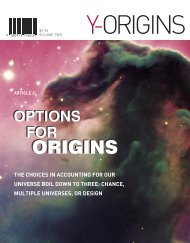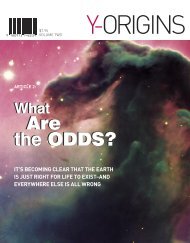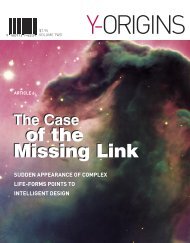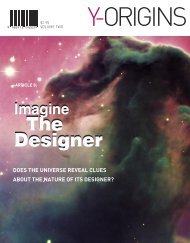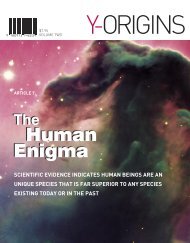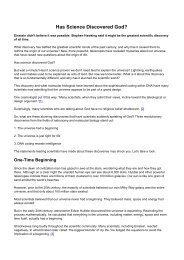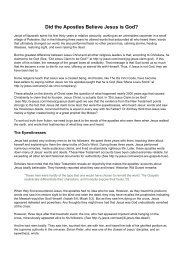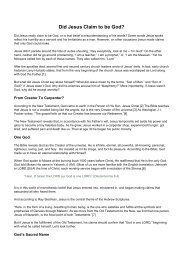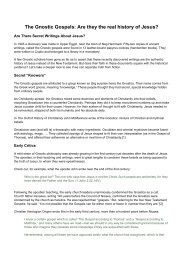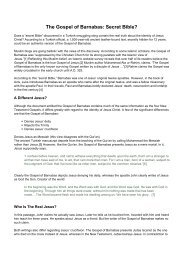Back_to_beginning1
Create successful ePaper yourself
Turn your PDF publications into a flip-book with our unique Google optimized e-Paper software.
$7.95<br />
VOLUME TWO<br />
Y-ORIGINS<br />
ARTICLE 1:<br />
<strong>Back</strong> <strong>to</strong><br />
<strong>Back</strong> <strong>to</strong><br />
The<br />
The<br />
Beginning<br />
Beginning<br />
SCIENTIFIC DISCOVERIES REVIVE<br />
THE ANCIENT BELIEF IN A BEGINNING<br />
TO THE UNIVERSE
INSTRUCTIONS<br />
To view the layout and graphics, click on the Facing icon on the<br />
right side of your bot<strong>to</strong>m <strong>to</strong>ol bar in your Acrobat Reader © file. Try viewing at 75%.<br />
To read the article, click on the Single Page icon on the bot<strong>to</strong>m right of your<br />
Acrobat Reader © file.<br />
To enlarge the print for easier viewing, click on the “+” by the<br />
magnifcation percentage in the middle of the <strong>to</strong>ol bar at the <strong>to</strong>p of the page.<br />
To move from one page <strong>to</strong> another, use your side scroll bar or click on the<br />
left or right arrow in the bot<strong>to</strong>m <strong>to</strong>ol bar.<br />
CLICK HERE <strong>to</strong> see other articles from Y-Jesus Magazine at www.y-zine.com<br />
Chief Edi<strong>to</strong>r: Larry Chapman<br />
Project Coordina<strong>to</strong>r: Helmut Teichert<br />
Edi<strong>to</strong>rial Direc<strong>to</strong>r: Rick James<br />
Design: Hydragraphik ® Studio ( www.hydragraphik.com )<br />
Sun Mountain Productions<br />
Article Edi<strong>to</strong>rs: Rick James, Eric Stanford<br />
Copy Edi<strong>to</strong>r: Eric Stanford<br />
Writers: Larry Chapman, Rick James, Eric Stanford<br />
Y-ZINE<br />
PO Box 6017<br />
Great Falls, MT 59405<br />
Copyright 2006 by Bright Media Foundation and B & L Publications. All rights reserved.<br />
ISBN 0-9717422-3-5<br />
2 • Y-JESUS
<strong>Back</strong> <strong>to</strong> the Beginning<br />
Click on the e-article title for contents<br />
SCIENCE RE-ENGAGES THE QUESTION OF THE AGES Page 6<br />
A GREAT BRAIN’S BIGGEST BLUNDER Page 6<br />
RED SHIFTING THE BIG BANG THEORY INTO HIGH GEAR Page 7<br />
A SECOND LAW OF FIRST IMPORTANCE Page 7<br />
THE SIGNIFANCE OF TV INTERFERENCE Page 8<br />
THE GREATEST DISCOVERY OF ALL TIME? Page 8<br />
THE QUESTIONS THAT FOLLOW THE EVIDENCE Page 9<br />
TRYING TO AVOID THE BAD DREAM Page 9<br />
A ONE TIME BEGINNING Page 10<br />
ENDNOTES Page 11<br />
IS THE DESIGNER AN ABSENTEE PARENT? Page 13<br />
ACKNOWLEDGMENTS<br />
I am indebted <strong>to</strong> Dr. Bill Bright, who passed away before this project was finished. Dr. Bright enthusiastically endorsed and<br />
contributed <strong>to</strong> the development of the material presented in this endeavor.<br />
Special thanks are also due <strong>to</strong> Rick James and Eric Stanford, who have both spent countless hours clarifying some of the concepts<br />
presented.<br />
Several others have contributed greatly <strong>to</strong> the writing of these articles, including Dr. Henry Brandt, Dave Chapman, Dr. Bert<br />
Harned, and New Testament scholar, Dr. Ron Heine. The valuable input from Brian Ricci, ‘Jamin Latvala, and the Campus Crusade<br />
staff at the University of Washing<strong>to</strong>n were especially helpful and constructive. Special thanks also are due Helmut Teichert of<br />
Bright Media, who has been the overall direc<strong>to</strong>r of the project. Finally I would like <strong>to</strong> thank my wife, Marianne, for inspiring me <strong>to</strong><br />
undertake this effort.<br />
Larry Chapman<br />
TABLE OF CONTENTS • 3
BACK TO THE<br />
BEGINNING<br />
4• BACK TO THE BEGINNING • ARTICLE 1
Scientific<br />
discoveries<br />
revive the<br />
ancient belief in<br />
a beginning <strong>to</strong><br />
the universe<br />
If we could rewind the his<strong>to</strong>ry<br />
of the universe, what would we<br />
discover about its origin and<br />
development?<br />
Did it really have a beginning,<br />
or was it always there?<br />
BACK TO THE BEGINNING • ARTICLE 1 • 5
The influential ancient philosopher Aris<strong>to</strong>tle<br />
stated, “It is impossible that movement<br />
should ever come in<strong>to</strong> being or cease <strong>to</strong> be,<br />
for it must always have existed. Nor can<br />
time come in<strong>to</strong> being or cease <strong>to</strong> be.”<br />
Meanwhile, the biblical book of Genesis<br />
famously starts off, “In the beginning God<br />
created the heavens and the earth.”<br />
Which is it? Is the universe eternal—has it<br />
always been here? Or did it have a beginning<br />
at some point in time—did it have a<br />
birthday, so <strong>to</strong> speak? These are the two<br />
schools of thought that have enrolled followers<br />
since early times. (Actually, there<br />
was also a third school that postulated that<br />
the universe existed on the back of a giant<br />
sea turtle, but they’re mostly gone now.)<br />
The seesaw of opinion has tipped one way<br />
or the other over time. But lately the weight<br />
of evidence has all been coming down on<br />
the side of the birthday universe.<br />
In the old days when the Christian church<br />
dominated Western society, the creation<br />
of the universe was taken for granted. But<br />
slowly the scientific viewpoint pushed<br />
aside creation as well as the crea<strong>to</strong>r. Now<br />
many scientists are thinking that the idea<br />
of a creation may not have been so far off<br />
from the truth as they thought. It’s looking<br />
like the universe had a beginning after all.<br />
Remarkably, one of the first scientists<br />
<strong>to</strong> swing the pendulum of opinion back<br />
<strong>to</strong> the birthday-universe position was so<br />
entrenched in eternal-universe thinking<br />
that at first he refused <strong>to</strong> believe his own<br />
conclusions.<br />
A<br />
GREAT<br />
BRAIN’S<br />
BIGGEST<br />
BLUNDER<br />
When Albert Einstein developed his revolutionary<br />
theory of general relativity in 1916,<br />
his mathematical calculations pointed <strong>to</strong><br />
an extraordinary conclusion—the universe<br />
was expanding. And since if you rewind<br />
the tape on any expansion, you get back<br />
<strong>to</strong> a point where it started, that meant the<br />
universe must have had a beginning <strong>to</strong>o. 1<br />
Einstein, however, was like most scientists<br />
of his day in that he believed in an eternal<br />
universe. Unwilling <strong>to</strong> accept a beginning<br />
<strong>to</strong> the universe, Einstein fudged the numbers<br />
in order <strong>to</strong> nullify the conclusion that<br />
the universe was expanding.<br />
University of California astrophysicist<br />
George Smoot explains that Einstein’s main<br />
problem with an expanding universe was<br />
its implication of a beginning. A beginning<br />
pointed <strong>to</strong> a beginner beyond scientific<br />
investigation. 2 However, once experimental<br />
data proved that the universe really was<br />
expanding, Einstein admitted his error, calling<br />
it “the biggest blunder of my life.” 3<br />
There’s a point worth considering here: if it<br />
could happen <strong>to</strong> Einstein, it could happen<br />
<strong>to</strong> anyone. Rarely is anyone completely<br />
objective when it comes <strong>to</strong> the issue of a<br />
crea<strong>to</strong>r. While it is true that religious belief<br />
and philosophy became an obstacle for<br />
scientific inquiry in the days of Galileo,<br />
trends have changed. In the modern era it<br />
has been a prejudice against the possibility<br />
of a cosmic designer that has kept many<br />
scientists from honest and open inquiry.<br />
Thankfully, the truth generally comes out<br />
in the end, and scientists began <strong>to</strong> see<br />
the light. For Einstein and others, it was<br />
something called red shift that started the<br />
parade of evidence for a universe with a<br />
beginning.<br />
6• BACK TO THE BEGINNING • ARTICLE 1
RED<br />
SHIFTING<br />
THE<br />
BIG<br />
BANG<br />
THEORY<br />
INTO<br />
HIGH<br />
GEAR<br />
In the late 1920s, the American astronomer<br />
Edwin Hubble noticed something unusual<br />
as he gazed in<strong>to</strong> the heavens. It wasn’t<br />
a new planet or little green men waving<br />
at him from Mars; it was something more<br />
tedious and at the same time more thrilling.<br />
Hubble had been spending countless<br />
nights at the Mount Wilson Observa<strong>to</strong>ry,<br />
studying the stars and galaxies and especially<br />
the spectrum of color in the light they<br />
sent our way. He discovered that the light<br />
from most other galaxies was shifted <strong>to</strong> the<br />
red end of the spectrum, which indicated<br />
they were moving away from us. Furthermore,<br />
the farther a galaxy was away from<br />
us, the more red shifted its light was and,<br />
thus, the faster it was moving away from<br />
us.<br />
The only explanation for all of this was that<br />
space itself was expanding, causing all<br />
galaxies <strong>to</strong> move away from each other. In<br />
an expanding universe, from any point in<br />
space (including our own), it would appear<br />
that most stars and galaxies were racing<br />
away. And the farther away they were, the<br />
faster they would be racing.<br />
There it was in the red shift: proof that<br />
Einstein had been right in the first place<br />
(before he fudged his formula) and that<br />
the universe really was expanding. Proof,<br />
in other words, that the universe was not<br />
eternal but had a beginning. 4<br />
And yet not everyone accepted the proof at<br />
first, including a scientist named Sir Fred<br />
Hoyle (former Plumian professor of astronomy<br />
at Cambridge University and founder of<br />
the Institute of Astronomy at Cambridge).<br />
Ironically, it was Hoyle who originally described<br />
the event as a “big bang,” meaning<br />
<strong>to</strong> mock the idea. The name stuck. (According<br />
<strong>to</strong> physics professor Brian Greene,<br />
the term “big bang” is actually misleading<br />
since there was nothing <strong>to</strong> explode and<br />
no space in which an explosion could take<br />
place.) 5 But unlike Hoyle, many other scientists<br />
began coming over <strong>to</strong> the side of the<br />
newly named theory.<br />
The world’s leading astrophysicist, Stephen<br />
Hawking, who has held the esteemed position<br />
of Lucasian Professor of Mathematics<br />
at Cambridge, calls Hubble’s discovery of<br />
an expanding universe “one of the great<br />
intellectual revolutions of the twentieth<br />
century.” 6 The discovery that the universe<br />
had a beginning has led <strong>to</strong> a new science<br />
called cosmology, which attempts <strong>to</strong><br />
understand what happened at the origin of<br />
the universe, how it works, and what will<br />
happen in its future.<br />
The new science led cosmologists <strong>to</strong> take<br />
another look at a seemingly mundane insight<br />
from the 19th century, the second law<br />
of thermodynamics.<br />
A<br />
SECOND<br />
LAW<br />
OF<br />
FIRST<br />
IMPORTANCE<br />
In addition <strong>to</strong> Hubble’s discovery, the second<br />
law of thermodynamics also predicts<br />
a beginning <strong>to</strong> the universe. You say you<br />
don’t know the second law of thermodynamics?<br />
Think again.<br />
Let’s say you come in<strong>to</strong> a room containing<br />
me and a bunch of your other pals, and you<br />
find a steaming cup of Starbucks coffee on<br />
BACK TO THE BEGINNING • ARTICLE 1 • 7
the table. Being the thoughtful individual<br />
that you are, you ask, “Does this belong <strong>to</strong><br />
anyone?”<br />
To which I reply, “It’s been there for the last<br />
month.”<br />
Well, you’d know immediately I was wrong<br />
or lying (probably lying). Why? Because<br />
the coffee wouldn’t still be hot if it had<br />
been there for a month; it would be room<br />
temperature.<br />
That’s the second law of thermodynamics<br />
in action. This law states that everything<br />
continually moves from a state of order <strong>to</strong><br />
disorder and that heat and energy dissipate<br />
over time. This is a law that has been verified<br />
by proof after scientific proof and has<br />
never been shown <strong>to</strong> be wrong.<br />
Now let’s apply this law <strong>to</strong> the universe,<br />
just as cosmologists have. If the universe<br />
were eternal, it would have gone cold and<br />
lifeless long ago. The stars would have<br />
burned out. Planets would have broken<br />
up in<strong>to</strong> clouds of dust. And even the black<br />
holes would have ceased vacuuming the<br />
universe of unsightly stars and planets.<br />
When you see flaming suns and scorching<br />
meteors, in other words, you’re looking at<br />
a steaming cup of coffee that over infinite<br />
time would have long since gone room<br />
temperature. Since the universe is still full<br />
of pockets of heat and energy, it cannot be<br />
eternal.<br />
Who would have thought heat would be<br />
such a helpful clue? And that’s just the half<br />
of it.<br />
THE<br />
SIGNIFICANCE<br />
OF<br />
TV<br />
INTERFERENCE<br />
There is still another way that the measurement<br />
of heat help <strong>to</strong> prove that the universe<br />
is expanding. In the spring of 1964, two researchers<br />
at Bell Labs observed a persistent<br />
hiss while testing their microwave radiation<br />
detec<strong>to</strong>r. Regardless of which direction they<br />
pointed the antenna, the static was the<br />
same. (This is the same static as TV interference.<br />
The same static that was supposed<br />
<strong>to</strong> be gone when I paid $150 <strong>to</strong> have my<br />
satellite dish installed.) Those men, Arno<br />
Penzias and Robert Wilson, had discovered<br />
what scientists say is the echo from the<br />
birth of the universe. 7<br />
But how could scientists know for sure that<br />
the hiss they were hearing was actually an<br />
echo from the beginning of the universe?<br />
Mathematicians calculated that heat generated<br />
at the moment the universe began<br />
would have been enormous beyond comprehension.<br />
This heat would have gradually<br />
dissipated over the life of the cosmos, leaving<br />
only a tiny residual of about 3 degrees<br />
Kelvin (–270 degrees C).<br />
Additionally, in order for galaxies <strong>to</strong> have<br />
formed, the pattern formed by the explosion<br />
needed <strong>to</strong> have slight variations in the form<br />
of waves or ripples.<br />
According <strong>to</strong> George Smoot, these ripples<br />
would result in very slight fluctuations<br />
in the predicted temperature and would<br />
reveal an identifiable pattern. 8 Thus, if the<br />
temperatures matched up, the birth of the<br />
universe would be scientifically verified.<br />
Merely discovering the temperature <strong>to</strong> be<br />
3 degrees Kelvin would not prove that the<br />
universe actually had a beginning; the<br />
fluctuations also needed <strong>to</strong> match. 9<br />
But how could we verify fluctuations so<br />
subtle?<br />
THE<br />
GREATEST<br />
DISCOVERY<br />
OF<br />
ALL<br />
TIME?<br />
In 1992, a team of astrophysicists led by<br />
Smoot launched the COBE satellite in<br />
order <strong>to</strong> verify the temperatures in space.<br />
The satellite would be able <strong>to</strong> take precise<br />
measurements and determine whether<br />
fluctuations in temperature existed.<br />
The results stunned the scientific world.<br />
Not only was the three-degree temperature<br />
confirmed, but more importantly, the profiles<br />
of the fluctuations were discovered <strong>to</strong><br />
be a match with what had been expected. 10<br />
Hawking called the discovery “the scientific<br />
discovery of the century, if not all time.”<br />
Smoot himself excitedly stated <strong>to</strong> news-<br />
8• BACK TO THE BEGINNING • ARTICLE 1
paper reporters, “What we have found is<br />
evidence for the birth of the universe.” 11 He<br />
also said, “If you’re religious, it’s like looking<br />
at God.” 12<br />
than ever before. 16 <strong>Back</strong>ground radiation<br />
measurements exceed 99.9% of what had<br />
been predicted. 17 There are now more than<br />
30 independent confirmations that the<br />
universe had a one-time origin. 18<br />
<strong>to</strong> materialists). Smoot admits, “There is no<br />
doubt that a parallel exists between the big<br />
bang as an event and the Christian notion<br />
of creation from nothing.” 22<br />
THE EVIDENCE HAD BEGUN TO ADD UP,<br />
AND SOME SCIENTISTS WEREN’T LIKING THE SUM.<br />
As<strong>to</strong>unded by the news, Ted Koppel began<br />
his ABC Nightline television program with<br />
an astronomer quoting the opening of<br />
Genesis: “In the beginning God created the<br />
heavens and the earth.” The other special<br />
guest, a physicist, immediately added his<br />
quote of the third Bible verse: “And God<br />
said, ‘Let there be light,’ and there was<br />
light”. 13<br />
Evidence like that provided by the COBE<br />
satellite raises some intriguing questions,<br />
<strong>to</strong> say the least.<br />
THE<br />
QUESTIONS<br />
THAT<br />
FOLLOW<br />
THE<br />
EVIDENCE<br />
Einstein’s theorems based on his theory of<br />
relativity predict that the universe could not<br />
have begun without an outside force or Beginner.<br />
14 Since Einstein’s theory of relativity<br />
ranks as the most exhaustively tested and<br />
best proven principle in physics, his conclusion<br />
is deemed correct. 15<br />
Tests from an array of radio telescopes<br />
at the South Pole have confirmed the big<br />
bang <strong>to</strong> a still higher degree of accuracy<br />
New telescopes such as the infrared Spitzer<br />
Space Telescope, launched in 2003, have<br />
opened up even bigger windows <strong>to</strong> our<br />
universe. They have prompted astronomer<br />
Giovanni Fazio, from the Harvard-Smithsonian<br />
Center for Astrophysics, <strong>to</strong> remark,<br />
“We are now able for the first time <strong>to</strong> lift the<br />
cosmic veil that has blocked our view.” 19<br />
As a result of the accumulating evidence,<br />
the scientific community has long since<br />
begun asking questions about origins, such<br />
as the following:<br />
• What was there before the big bang?<br />
• Why did the big bang result in a uni-<br />
verse enabling life <strong>to</strong> exist?<br />
• How could everything originate from<br />
nothing?<br />
Smoot ponders what was there before the<br />
beginning: “Go back further still, beyond<br />
the moment of creation—what then? What<br />
was there before the big bang? What was<br />
there before time began?” 20<br />
The same astrophysicist notes that “until<br />
the late 1910s … those who didn’t take<br />
Genesis literally had no reason <strong>to</strong> believe<br />
there had been a beginning.” 21 The Genesis<br />
account of creation and the big bang theory<br />
both speak of everything coming from<br />
nothing. Suddenly the Bible and science<br />
agree (a discovery somewhat embarrassing<br />
The evidence had begun <strong>to</strong> add up, and<br />
some scientists weren’t liking the sum.<br />
TRYING<br />
TO<br />
AVOID<br />
THE<br />
BAD<br />
DREAM<br />
A beginning <strong>to</strong> the universe was like a<br />
bad dream come true for materialists who<br />
wanted <strong>to</strong> believe everything had always<br />
existed. It brought scientists face <strong>to</strong> face<br />
with the logical conclusion that a primary<br />
cause must exist. That argument is a<br />
simple logical syllogism:<br />
1. Everything that has a beginning had<br />
a cause.<br />
2. The universe had a beginning.<br />
3. Therefore, the universe had a cause.<br />
But admitting a cause leads <strong>to</strong> the next<br />
logical question: who or what is the cause?<br />
Think about it for a minute. Since time,<br />
space, matter, and motion are all a part<br />
of the created universe, then before the<br />
beginning it was timeless, spaceless, and<br />
motionless.<br />
What can happen spontaneously from this<br />
BACK TO THE BEGINNING • ARTICLE 1 • 9
state of affairs? There’s nothing moving,<br />
there’s nothing colliding, there’s … well,<br />
nothing. Not even the potential for anything<br />
<strong>to</strong> happen.<br />
The fact that everything came from nothing<br />
has forced scientists <strong>to</strong> acknowledge<br />
that something outside of space and time,<br />
something very powerful and with apparent<br />
volition, must have acted <strong>to</strong> bring about the<br />
beginning. That is, there must have been<br />
an intelligent designer of the universe.<br />
Some might go ahead and use the name<br />
God for this crea<strong>to</strong>r.<br />
Well, in certain academic circles, this line<br />
of reasoning simply won’t do. Thus it is that<br />
many materialists have looked for a way <strong>to</strong><br />
prove that the universe didn’t have a beginning.<br />
Smoot remarks, “Cosmologists have<br />
long struggled <strong>to</strong> avoid this bad dream by<br />
seeking explanations of the universe that<br />
avoid the necessity of a beginning.” 23<br />
Sir Fred Hoyle (he who mockingly coined<br />
the term “big bang”) was one scientist who<br />
strongly opposed the concept of a beginning<br />
for the universe. In 1948 Hermann<br />
Bondi and Thomas Gold joined Hoyle in<br />
postulating that matter was in a continual<br />
state of creation. They called their idea the<br />
steady state theory, which was an attempt<br />
<strong>to</strong> show that the universe is eternal after<br />
all, even though the evidence had long<br />
been trending against such a view. However,<br />
the COBE discovery of background<br />
radiation was the fatal blow <strong>to</strong> the steady<br />
state theory. 24<br />
Next came the oscillating-universe theory.<br />
According <strong>to</strong> this concept, the universe<br />
explodes, contracts, and explodes again,<br />
eternally yo-yoing. This would be another<br />
way <strong>to</strong> permit a belief in the eternal existence<br />
of the universe. But the physics for<br />
this theory didn’t work.<br />
More recently, some scientists, including<br />
Hawking, have begun considering the<br />
so-called multiverse theory. This theory<br />
accepts that our universe is finite, but<br />
it suggests that ours is just one of many<br />
universes. The whole multi-universe may<br />
be eternal, according <strong>to</strong> this theory, even<br />
though our particular universe is not. This<br />
theory is covered in more depth in another<br />
article in this magazine, but the key point<br />
<strong>to</strong> understand about it right now is that it<br />
has no evidence whatsoever <strong>to</strong> support it.<br />
These theories fit neatly with the philosophy<br />
of materialism, whereas a beginning of<br />
the universe would raise the obvious question,<br />
who was there <strong>to</strong> start it? Professor<br />
Dennis Sciama, Hawking’s supervisor while<br />
he was at Cambridge, admits his reasons<br />
for supporting the steady state theory: “I<br />
was a supporter of the steady state theory,<br />
not in the sense that I believed that it had<br />
<strong>to</strong> be true, but in that I found it so attractive<br />
I wanted it <strong>to</strong> be true.” 25<br />
An origin of the universe meant materialists<br />
were suddenly faced with the questions<br />
that threatened their worldview.<br />
A<br />
ONE<br />
TIME<br />
BEGINNING<br />
Hoyle and other scientists fervently pursued<br />
alternative explanations <strong>to</strong> a onetime<br />
origin of the universe. Eventually,<br />
however, the evidence showed clearly that<br />
the universe had a beginning, and the big<br />
bang theory was proclaimed vic<strong>to</strong>rious.<br />
Ironically, it was evidence from Hoyle’s<br />
own research that helped confirm that the<br />
universe had a one-time beginning.<br />
Today most cosmologists and physicists<br />
accept the big bang theory as the scientific<br />
explanation of how our universe began. In<br />
fact, scientists believe they can trace the<br />
his<strong>to</strong>ry of the universe all the way back <strong>to</strong><br />
10 -43 of a second. Prior <strong>to</strong> that point in the<br />
his<strong>to</strong>ry of our universe, all of our current<br />
theories break down and science can see<br />
no further back. The very beginning of the<br />
universe remains a mystery.<br />
10• BACK TO THE BEGINNING • ARTICLE 1
Imagine rewinding the universe back <strong>to</strong><br />
its beginning, a time when there were<br />
no stars. No light, matter, or energy. Not<br />
even space or time. Suddenly an enormous<br />
explosion erupted from this nothingness at<br />
a temperature exceeding a million trillion<br />
trillion degrees. 26 Time begins along with<br />
matter, energy, and space.<br />
When a bomb ejects shrapnel in<strong>to</strong> the air,<br />
both the bomb material and the space<br />
it blows in<strong>to</strong> have already been there.<br />
However, in the beginning of the universe,<br />
neither space nor matter existed until the<br />
explosion. The space surface of the universe<br />
and the newly created matter came<br />
in<strong>to</strong> existence.<br />
According <strong>to</strong> the big bang theory, this explosion<br />
launched the entire universe, from<br />
the most distant galaxy, <strong>to</strong> the most colorful<br />
nebula, <strong>to</strong> quasars flashing like beacons, <strong>to</strong><br />
our own comforting sun and nearby planets,<br />
<strong>to</strong> you and me with our questions about<br />
where we came from and what it all means.<br />
Since man alone thinks about the meaning<br />
and purpose of life, the beginning—and the<br />
cause of that beginning—must be fascinating<br />
<strong>to</strong> each one of us.<br />
The verdict is in on whether the universe is<br />
eternal or had a beginning. The idea that<br />
everything in the cosmos originated out<br />
of nothing seems mythical, yet it is now<br />
mainstream science.<br />
ENDNOTES<br />
1. Brian Greene, The Elegant Universe<br />
(New York: Vintage, 2000), 81-82.<br />
2. George Smoot and Keay Davidson, Wrinkles<br />
in Time (New York: Avon, 1993), 36.<br />
3. Greene, 81-82.<br />
4. Stephen Hawking, A Brief His<strong>to</strong>ry of<br />
Time (New York: Bantam, 1990), 38-51.<br />
5. Greene, 83.<br />
6. Hawking, 39.<br />
7. Smoot, 80-83.<br />
8. Ibid., 187.<br />
9. Ibid., 240.<br />
10. Ibid., 241.<br />
11. Associated Press, “U.S. Scientists Find<br />
a ‘Holy Grail’: Ripples at the Edge of the<br />
Universe,” International Herald Tribune<br />
(London), April 24, 1992, 1.<br />
12. Thomas H. Maugh II, “Relics of ‘Big<br />
Bang’ Seen for First Time,” Los Angeles<br />
Times, April 1992, A1, A30.<br />
13. Nightline with Ted Koppel, ABC, April<br />
25, 1992.<br />
14. Hugh Ross, The Crea<strong>to</strong>r and the<br />
Cosmos, 3rd ed. (Colorado Springs, CO:<br />
NavPress, 2001), 224.<br />
15. Roger Penrose, Shadows of the Mind<br />
(New York: Oxford University Press, 1994),<br />
230.<br />
16. E. M. Leitch et al., “Measurement of<br />
Polarization with the Degree Angular Scale<br />
Interferometer,” Nature 420 (2002): 772-87;<br />
J. M. Kovac et al., “Detection of Polarization<br />
in the Cosmic Microwave <strong>Back</strong>ground<br />
Using DASI,” Nature 420 (2002): 772-87;<br />
Matias Zalarriaga, “<strong>Back</strong>ground Comes <strong>to</strong><br />
the Fore,” Nature 420 (2002): 747-48.<br />
17. Gregg Easterbrook, “Before the Big<br />
Bang,” U.S. News & World Report special<br />
edition, 2003, 16.<br />
18. Hugh Ross, “Big Bang Passes Test,”<br />
Connections, Qtr 2, 2003.<br />
19. Paul Recer, “Newest Space Telescope:<br />
The Spitzer,” Seattle Post Intelligencer,<br />
December 19, 2003, A17.<br />
20. Smoot, 291.<br />
21. Ibid., 30.<br />
22. Ibid., 17.<br />
23. Ibid., 291.<br />
24. Ibid., 86.<br />
25. Stephen Hawking, ed., Stephen Hawking’s<br />
A Brief His<strong>to</strong>ry of Time: A Reader’s<br />
Companion (New York: Bantam, 1992), 63.<br />
26. Bradford A. Smith, “New Eyes on the<br />
Universe,” National Geographic, January<br />
1994, 33.<br />
27. Michio Kaku & Jennifer Thompson,<br />
Beyond Einstein, (New York: Anchor Books,<br />
1995), 167.<br />
BACK TO THE BEGINNING • ARTICLE 1 • 11
12• BACK TO THE BEGINNING • ARTICLE 1
IS THE DESIGNER AN ABSENTEE PARENT?<br />
The big bang theory has reopened scientists’<br />
minds <strong>to</strong> the possibility that the<br />
universe was created by an intelligent<br />
designer. But if so, has that designer<br />
remained involved with the universe?<br />
Two discoveries, quantum mechanics and<br />
string theory, suggest the answer could<br />
be yes.<br />
In 1925, Werner Heisenberg shocked the<br />
scientific community by showing that the<br />
suba<strong>to</strong>mic world is unpredictable. In fact,<br />
it behaves unlike anything scientists had<br />
ever imagined and seems <strong>to</strong> betray common<br />
sense. This marked the start of the<br />
branch of physics known as quantum mechanics,<br />
which is the study of the behavior<br />
of microscopic particles. (A “quantum,” in<br />
physicspeak, is the smallest amount of any<br />
quantity, such as particles like electrons,<br />
quarks, and pho<strong>to</strong>ns.)<br />
What has fascinated scientists is that<br />
particles such as electrons, quarks, and<br />
pho<strong>to</strong>ns can appear from nowhere and disappear<br />
just as quickly. No one knows why.<br />
Furthermore, a quantum has an undetermined<br />
position until it is observed.<br />
When observed, it immediately becomes<br />
a particle with a fixed position. Why does<br />
this happen? Again, scientists don’t have<br />
a clue.<br />
In another bizarre phenomenon known<br />
as quantum tunneling, a particle can<br />
move through a barrier without altering<br />
the barrier’s structure. Theoretically, the<br />
same might be possible for an object or<br />
person. Thus, phenomena such as walking<br />
un<strong>to</strong>uched through walls—previously<br />
thought <strong>to</strong> be a violation of the laws of<br />
physics—are possible.<br />
Physicists have been perplexed at the<br />
seeming contradiction of quantum<br />
mechanics and relativity, yet they are convinced<br />
that there must be some unifying<br />
principle. A newer concept in theoretical<br />
physics, known as string theory, may solve<br />
the riddle of how these bedrock theories<br />
are able <strong>to</strong> coexist in the cosmos.<br />
String theory likens the behavior of particles<br />
<strong>to</strong> tiny vibrating strings. Different<br />
vibrations create different behaviors for<br />
particles just as different vibrations on a violin<br />
or piano string can alter pitch. Among<br />
other things, string theory tells us that at<br />
the big bang at least six additional dimensions<br />
were created along with the four we<br />
observe (length, height, width, and time).<br />
These additional dimensions are beyond<br />
our ability <strong>to</strong> see or measure.<br />
The implications of string theory on our<br />
perception of reality are mind-boggling<br />
and require thinking differently about the<br />
universe and what is possible. If we could<br />
access other dimensions, the following<br />
“impossibilities” would be possible. 27<br />
1. Walking through objects, such as<br />
walls<br />
2. Performing surgery without cutting<br />
the skin<br />
3. Instant teleportation from one location<br />
<strong>to</strong> another<br />
If these other dimensions exist, a designer<br />
could theoretically intervene in our world<br />
without being seen. Quantum mechanics<br />
and the possibility of other dimensions<br />
contradicts materialists’ belief that “if<br />
we can’t see and measure it—it must not<br />
exist.” But scientists are also baffled about<br />
another mystery of the universe that is<br />
possibly an even great challenge <strong>to</strong><br />
materialism: dark matter and energy.<br />
About 95% of the universe is made up of<br />
this “dark stuff” that consists of mysterious<br />
exotic matter and energy. Although dark<br />
matter is invisible, scientists can convincingly<br />
measure its gravitational pull.<br />
Theoretically, dark matter pervades our<br />
very breath. We are on a hurtling spaceship<br />
surrounded by an ocean of matter we<br />
cannot see!<br />
Two-thirds of the dark stuff consists of<br />
“dark energy.” Although dark matter is an<br />
enigma, dark energy is even more mysterious—scientists<br />
have no idea what it is.<br />
Some scientists believe dark energy holds<br />
the key <strong>to</strong> understanding the great mysteries<br />
of our universe.<br />
This mysterious dark stuff that pervades<br />
95% of the universe, along with the quantum<br />
world and other dimensions, have<br />
fueled new ideas about how a designer<br />
could be actively involved in his universe,<br />
yet remain unseen. Is it possible a<br />
designer operates in another dimension<br />
that intersects ours, or controls hidden<br />
quantum particle behavior that undergirds<br />
our macro world? Or could he be impacting<br />
our world from within the dark 95% of<br />
the universe that surrounds us?<br />
Taken <strong>to</strong>gether, these mysteries of our<br />
universe undermine the materialistic world<br />
view, and compel us <strong>to</strong> face the possibility<br />
that our universe was not only made<br />
but could also be sustained and cared for<br />
by a parent who guides the unseen world<br />
with his invisible hand. In that case, the<br />
designer could be less like a mother who<br />
abandons her newborn and more like a<br />
mom who stays with and raises her child.<br />
BACK TO THE BEGINNING • ARTICLE 1 • 13
“BACK TO THE BEGINNING” IS ONE OF EIGHT ARTICLES FROM<br />
Y-ORIGINS MAGAZINE<br />
DISCOVER IN Y-ORIGINS:<br />
Leading scientists like Einstein admit <strong>to</strong> a “superintelligence.”<br />
DNA causes leading atheist <strong>to</strong> renounce 50 years of unbelief<br />
DNA stuns evolutionists by tracing all humans <strong>to</strong> a single parent<br />
New theories predict other dimensions that make “miracles” possible<br />
The Crea<strong>to</strong>r has left clues in the cosmos that tell us what He is like.<br />
This colorful, easy-<strong>to</strong>-read magazine provides startling insights about our<br />
origins from such leading scientists as Stephen Hawking, Stephen Jay Gould,<br />
Roger Penrose, and Paul Davies.In his review of Y-Origins Jon Greene writes,<br />
“Y-Origins is a wonderful work on intelligent design, designed <strong>to</strong> appeal <strong>to</strong> the<br />
Y-generation. For readers who have never been exposed <strong>to</strong> the evidence for<br />
intelligent design, Y-Origins is a great introduction.”<br />
<strong>Back</strong> <strong>to</strong> the Beginning<br />
Scientific discoveries revive the ancient belief in a beginning <strong>to</strong> the universe.<br />
What are the Odds?<br />
It’s becoming clear that life on earth is unique and the odds against it existing elsewhere are<br />
astronomical.<br />
Options for Origins<br />
The choices in accounting for out universe boil down <strong>to</strong> three -—chance, multiple universes, or design.<br />
The Problem with Half an Eye<br />
Can intricately complex organs like the eye be the result of time plus chance?<br />
The Language of Our Cells<br />
Does the intelligence of DNA point <strong>to</strong> a Designer?<br />
The Case of the Missing Links<br />
Where are Darwin’s predicted fossils?<br />
The Human Enigma<br />
Evolutionists are unable <strong>to</strong> explain the origin of human intelligence and consciousness.<br />
Imagine the Designer<br />
Does the universe reveal clues about the nature of its designer?<br />
CLICK HERE <strong>to</strong> read excerpts from these articles at www.y-Jesus.com
HELPFUL WEBSITES<br />
IN YOUR DISCOVERY OF THE REAL JESUS:<br />
Y-Origins Connection<br />
Articles, links and resources about new scientific discoveries<br />
that support intelligent design.<br />
www.y-Origins.com<br />
Y-Jesus Magazine<br />
investigates<br />
the evidence for<br />
Jesus Christ.<br />
Discovery Institute<br />
Discovery Institute is a nonpartisan public policy think tank<br />
conducting research on technology, science and culture,<br />
economics and foreign affairs.<br />
www.discovery.com<br />
Origins<br />
Dedicated <strong>to</strong> intelligent design and philosophical theism, this<br />
site features articles by William A. Dembski, discussions on<br />
creation, evolution, theism, and atheism.<br />
www.origins.org<br />
Access Research Network on<br />
Origins and Design<br />
A site dedicated <strong>to</strong> providing accessible information<br />
on science, technology and society. It focuses on such<br />
controversial <strong>to</strong>pics as genetic engineering, euthanasia,<br />
computer technology, environmental issues, creation/<br />
evolution, fetal tissue research, AIDS, etc.<br />
www.arn.org<br />
Would You Like <strong>to</strong> Know God<br />
Personally?<br />
God loves you and wants you <strong>to</strong> know Him intimately. Four<br />
principles will help you discover how <strong>to</strong> know God personally<br />
and experience the abundant life He promised.<br />
www.KnowGodPersonally.org<br />
WE WOULD LIKE TO HEAR FROM YOU.<br />
CLICK HERE <strong>to</strong> give us your comments<br />
DISCOVER IN Y-JESUS<br />
• Scholars examine the facts<br />
• Relevant illustrations<br />
• Dramatic pho<strong>to</strong>s<br />
• Contemporary graphics<br />
• Easy <strong>to</strong> read and understand<br />
Y-Jesus is a full color,<br />
100 page magazine.<br />
To get a copy of<br />
Y-Origins Magazine<br />
visit www.Y-zine.com<br />
or mail $7.95 per magazine <strong>to</strong>:<br />
Y-Zine<br />
P.O. BOX 6017<br />
Great Falls, MT 59405<br />
(Shipping & handling is free<br />
in continental United States)



